#tapioca starch
Explore tagged Tumblr posts
Text

Fudgy Gluten Free Brownies
#fudge#chocolate#gluten free#brownies#bars#baking#recipe#gooey#kids#chocolate chip#dark chocolate#tapioca flour#tapioca#tapioca starch#butternutbakeryblog
227 notes
·
View notes
Text

Simple Gnocchi alla Sorrentina with Fresh Gnocchi (Vegan)
pillowy 2-ingredient plump fresh potato gnocchi baked in a from-scratch pomodorino sauce and dairy free creamy mozzarella
#vegan#lunch#dinner#italian cuisine#mediterranean cuisine#pasta#gnocchi#diy#potato#sauces#pomodorino sauce#tomatoes#gnocchi alla sorrentina#basil#garlic#olive oil#black pepper#sea salt#vegan mozzarella#:#beans#miso#apple cider vinegar#nutritional yeast#tapioca starch#lemon
122 notes
·
View notes
Text



Gluten Free Cookie Dough Brioche Rolls (via The Loopy Whisk)
#gluten free#gf food#gluten free foods#flour mix#sorghum flour#millet flour#tapioca starch#psyllium husk#breads#dessert#cookie dough#theloopywhisk
19 notes
·
View notes
Text
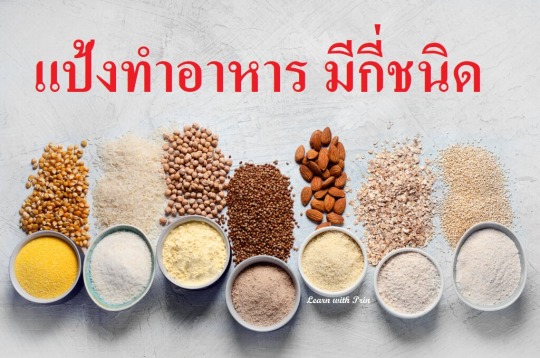
“แป้งทำอาหาร" มีกี่ชนิด

“แป้งทำอาหาร" มีกี่ชนิด
แป้งทำอาหาร มีกี่ชนิด แป้งชนิดไหนเหมาะจะนำมาทำอะไร เราไปดูกันเลยค่ะ
1. แป้งข้าวเจ้า (Rice flour)
แป้งข้าวเจ้า หรือบางทีก็เรียกว่า แป้งญวณ ทำมาจาก เมล็ดข้าวจ้าว จับแล้วสากมือ เมื่อใช้มือสัมผัสจะมีความหยาบเล็กน้อย แต่สากมือกว่าแป้งสาลี พอทำให้สุกแล้วตัวแป้งจะมีสีขาวขุ่น จับตัวกันเป็นก้อน เหมาะสำหรับนำไปทำอาหารที่ต้องการความอยู่ตัว เนื้อขนมจะมีความแข็งร่วน
เมนูที่ทำจากแป้งข้าวจ้าว ได้แก่ ขนมกล้วย ขนมเบื้อง ขนมดอกจอก ลอดช่อง ขนม ขนมตาล ขนมชั้น ขนมถ้วยตะไล (ขนมถ้วย) ซึ่งแป้งข้าวเจ้าถือว่าเป็นแป้งที่ถูกนำมาทำขนมไทยมากที่สุด
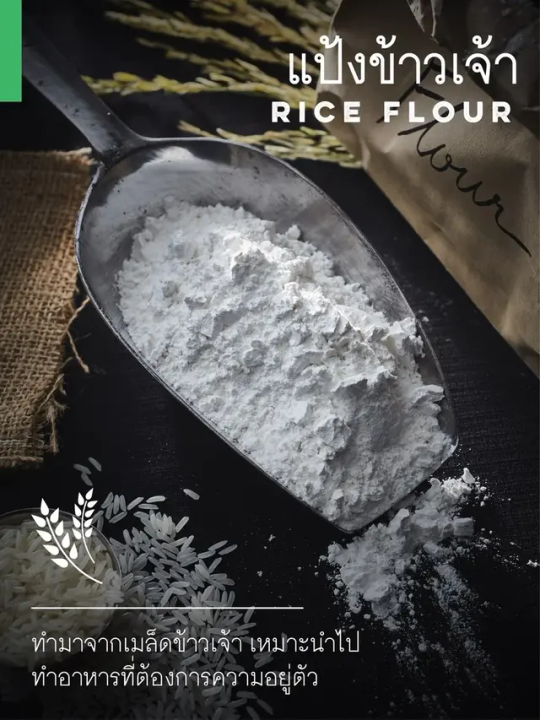
แป้งข้าวเจ้า
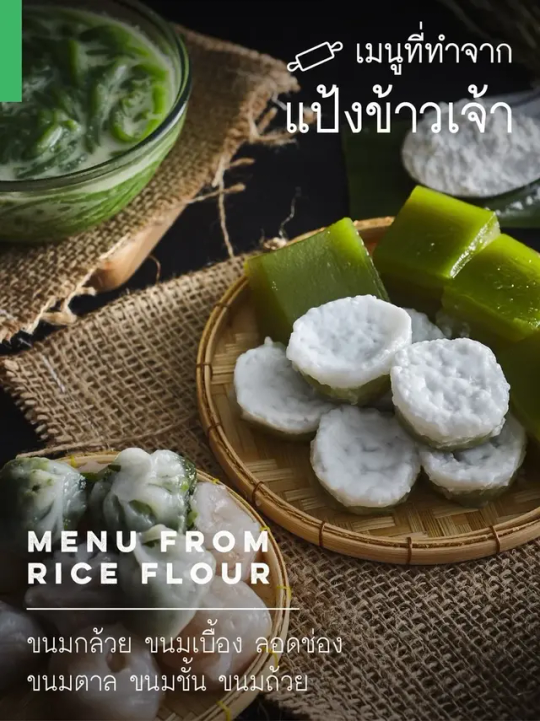
เมนูที่ทำจากแป้งข้าวจ้าว
2. แป้งข้าวเหนียว (Glutinous flour)
แป้งข้าวเหนียว ทำมาจากเมล็ดข้าวเหนียว มีลักษณะคล้าย ๆ กับแป้งข้าวเจ้าคือเป็นผงสีขาวๆ เมื่อใช้มือสัมผัสจะมีความหยาบเล็กน้อยกว่าแป้งข้าวเจ้า พอทำให้สุกแล้วตัวแป้งจะมีสีขาวขุ่นข้น มีความเหนียว
เมนูที่ทำจากแป้งข้าวเหนียว ได้แก่ ขนมต้ม บัวลอย ขนมถั่วแปบ ข้าวเหนียวตัด ขนมเทียน ขนมเข่ง ข้าวเหนียวเปียก ขนมบ้าบิ่น ขนมโก๋ แป้งจี่ ขนมโค ซึ่งบางเมนูที่ไม่ต้องการความเหนียวมากนักก็ให้ผสมแป้งข้าวเจ้าลงไปค่ะ
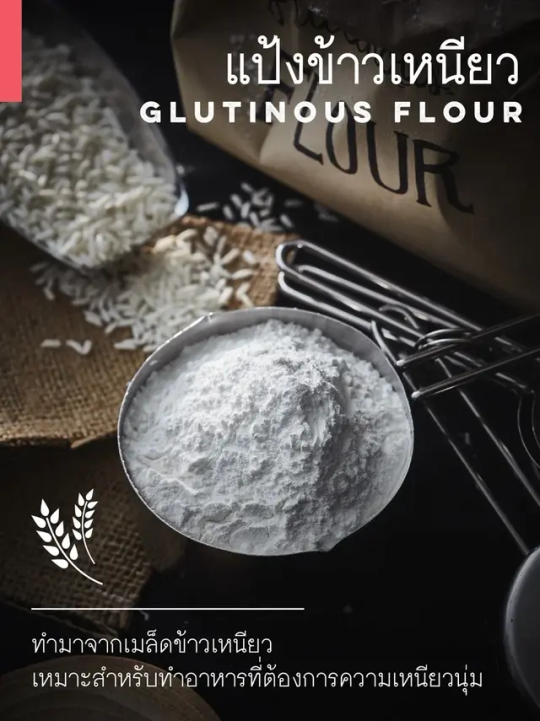
แป้งข้าวเหนียว
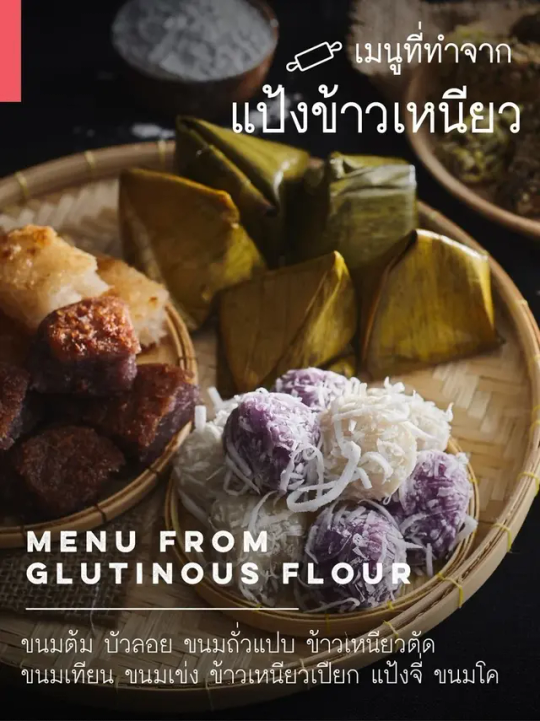
เมนูที่ทำจากแป้งข้าวเหนียว
3. แป้งมันสำปะหลัง (Tapioca starch / Cassava starch)
แป้งมันสำปะหลังหรือแป้งมัน บางทีก็เรียกว่า แป้งมันสิงคโปร์ ทำมาจาก หัวมันสำปะหลัง เป็นผงสีขาว เนื้อแป้งมีความละเอียด ลื่นมือ เมื่อถูกทำให้สุกแล้วตัวแป้งจะเหนียวหนืด มีสีใส เหมาะกับการนำไปทำอาหารที่มีความเหนียวแต่ใสและดูขึ้นเงา แต่ข้อเสียของแป้งมันสำปะหลังคือ เมื่อถูกทำให้เย็นลงจะคืนตัวง่ายมาก จึงมีการนำแป้งชนิดอื่นมาผสมเพื่อทำให้ขนมมีความเหนียวนุ่มขึ้น
เมนูที่ทำจากแป้งมันสำปะหลัง ได้แก่ ลอดช่องสิงโปร์ เต้าส่วน บัวลอย ครองแครงแก้ว ทับทิมกรอบ ขนมชั้น ขนมปลากริมไข่เต่า เป็นต้น ส่วนอาหารคาว ได้แก่ กุยช่ายทอดหรือหอยทอด ซึ่งต้องผสมแป้งผสมแป้งสาลีลงไปเพื่อให้ได้ความกรอบและนุ่ม เพราะถ้าใช้แป้งมันสำปะหลังอย่างเดียวอาหารทอดจะไม่กรอบ

แป้งมันสำปะหลังหรือแป้งมัน
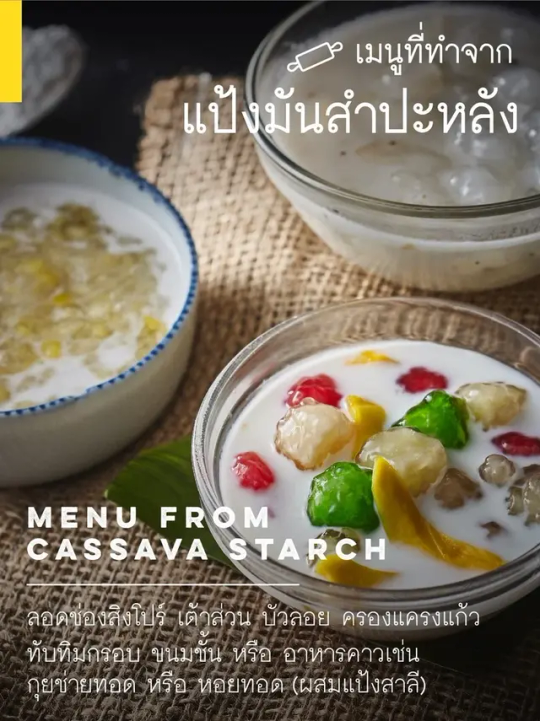
เมนูที่ทำจากแป้งมันสำปะหลัง
4.1. แป้งข้าวโพด บดละเอียด (Corn starch)
แป้งข้าวโพด บดละเอียด ทำมาจากเมล็ดข้าวโพด เป็นผงสีขาวเหลืองนวล เนื้อแป้งเนียนและลื่นมือ ข้อดีของแป้งข้าวโพดคือ เมื่อถูกทำให้สุกแล้วเนื้อแป้งจะข้นเหนียว มีความใสและไม่คืนตัว
เมนูที่ทำจากแป้งข้าวโพด บดละเอียด ได้แก่ ราดหน้า ไส้ขนม รวมถึงซอสต่างๆ ด้วย
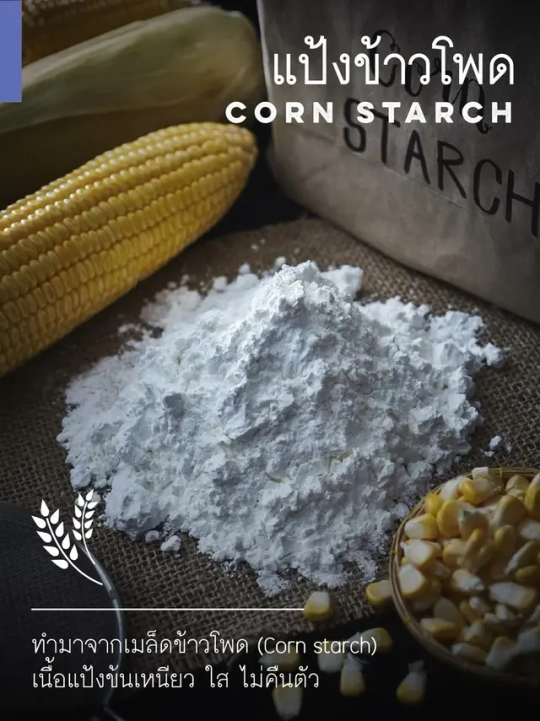
แป้งข้าวโพด บดละเอียด
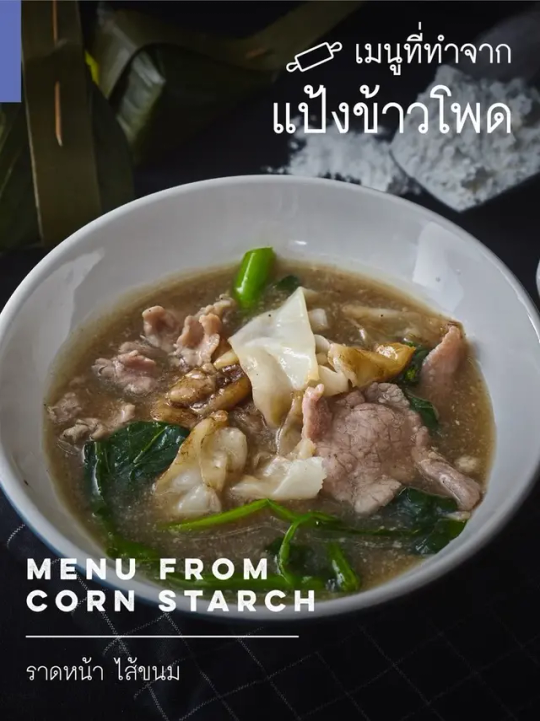
เมนูที่ทำจากแป้งข้าวโพด บดละเอียด
4.2. แป้งข้าวโพด บดหยาบ (Corn Meal)
แป้งข้าวโพด บดหยาบ ทำมาจากเมล็ดข้าวโพดบด แต่ไม่ละเอียดเท่ากับ Corn starch เนื้อจะหยาบกว่า
เมนูที่ทำจากแป้งข้าวโพด บดหยาบ (Corn Meal) ได้แก่ มัฟฟิน และขนม
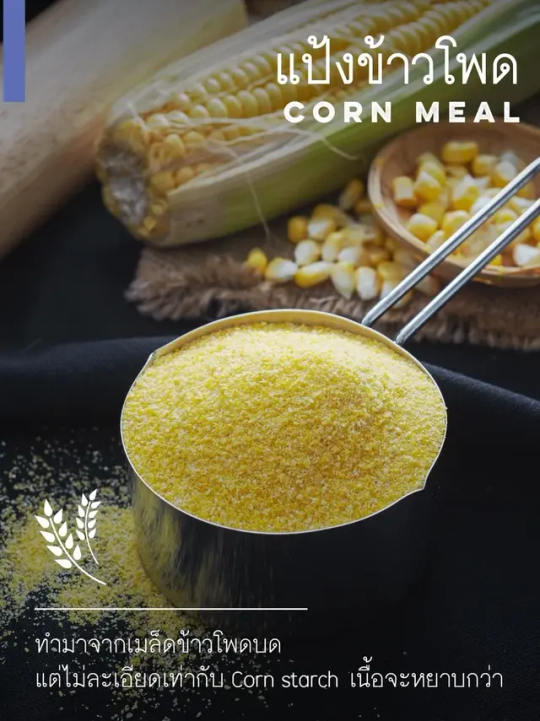
แป้งข้าวโพด บดหยาบ

เมนูที่ทำจากแป้งข้าวโพด บดหยาบ
5. แป้งเท้ายายม่อม (Arrowroot Starch)
แป้งเท้ายายม่อม ทำมาจากหัวมันเท้ายายม่อม เป็นแป้งที่มีราคาสูงกว่าแป้งชนิดอื่นๆ เพราะหัวมันเท้ายายม่อมนั้นสามารถเก็บเกียวได้แค่ปีละครั้ง แถมวิธีการทำแป้งก็ค่อนข้างยุ่งยากซับซ้อน ตัวแป้งจะมีลักษณะเป็นเมล็ดสี่เหลี่ยมเล็กๆ สีขาว เนื้อสัมผัสจะมีความหยาบมากเมื่อเทียบกับแป้งชนิดอื่นๆ ก่อนนำมาทำอาหารต้องนำมาบดให้ละเอียดและร่อนเสียก่อน เมื่อโดนความร้อนจนสุกแล้ว ตัวแป้งจะมีลักษณะข้น เหนียวหนืดและมีความใส นิยมนำมาผสมกับแป้งชนิดอื่นแล้วนำไปทำอาหารที่ต้องการความข้นเหนียวและมันวาว
เมนูที่ทำจากแป้งเท้ายายม่อม ได้แก่ ขนมชั้น ขนมเปียกปูน ขนมน้ำดอกไม้ ลอดช่องต่างๆ แต่จะต้องผสมกับแป้งข้าวเจ้าลงไปด้วย
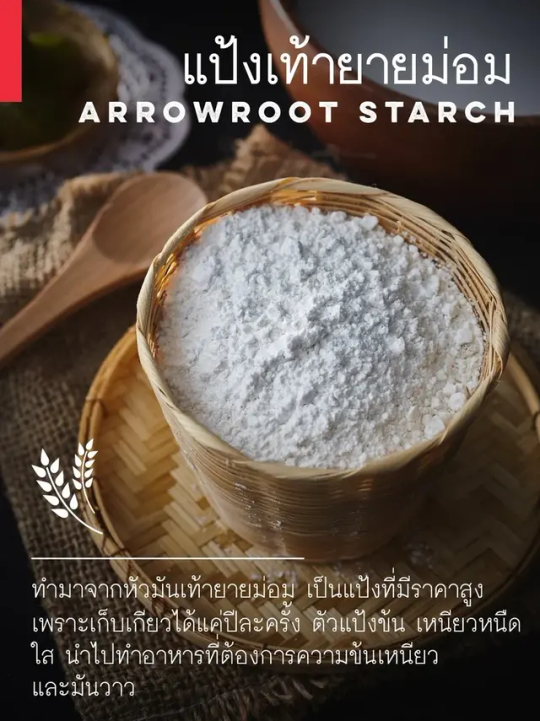
แป้งเท้ายายม่อม
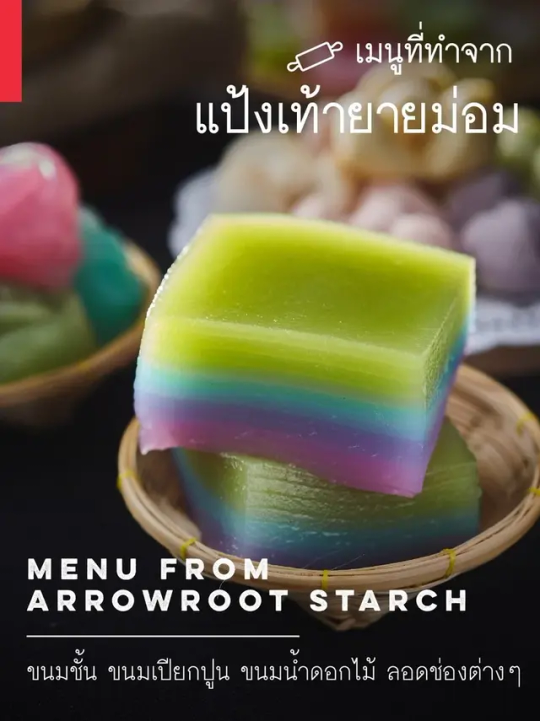
เมนูที่ทำจากแป้งเท้ายายม่อม
6. แป้งถั่วเขียว (Mung bean Starch)
แป้งถั่วเขียว ทำมาจากเมล็ดถั่วเขียว เป็นผงสีขาว เนื้อแป้งสากมือเล็กน้อย ตัวแป้งเมื่อสุกแล้วจะมีลักษณะใสคล้ายกับวุ้น มีความมันเงา เมื่อพักให้เย็นตัวลงก็จะจับตัวเป็นก้อนแข็งแต่เด้ง อยู่ตัว
เมนูที่ทำจากแป้งถั่วเขียว ได้แก่ อาหารที่มีความอยู่ตัว อย่าง ตะโก้ ซ่าหริ่ม ลอดช่องแก้ว ขนมลืมกลืน

แป้งถั่วเขียว
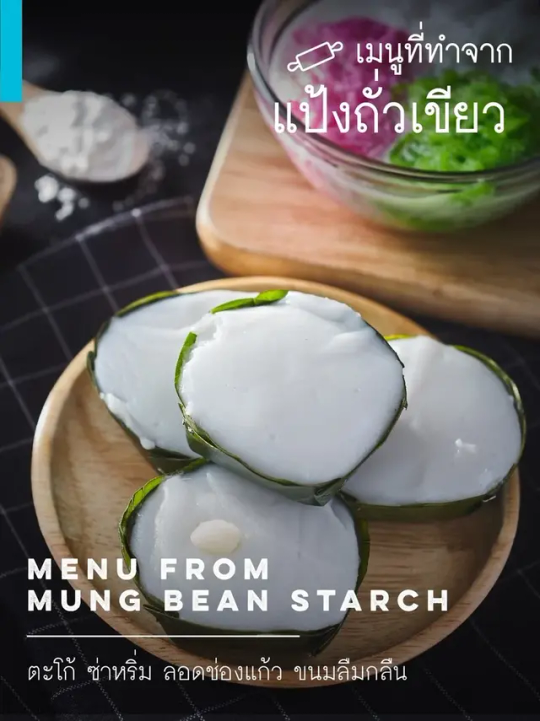
เมนูที่ทำจากแป้งถั่วเขียว
7.1. แป้งสาลีสำหรับทำขนมปัง (Bread Flour / Hard Flour)
แป้งสาลีสำหรับทำขนมปัง ลักษณะเป็นผงสีขาวนวล เมื่อเอามือจับ��ูเนื้อจะค่อนข้างหยาบ ทำมาจากข้าวสาลีชนิดหนัก มีปริมาณโปรตีน 12-13%
เมนูที่ทำจากแป้งสาลีทำขนมปัง ได้แก่ โดนัทยีสต์ ปาท่องโก๋ โรตี พิซซ่า หรือเมนูทำขนมปังต่างๆ เพราะแป้งชนิดนี้จะดูดซับน้ำได้ดี มีความเหนียวและยืดหยุ่นดี
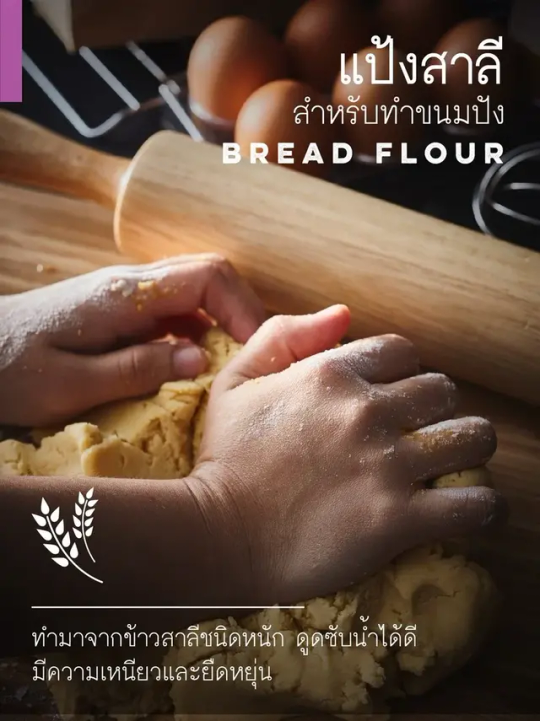
แป้งสาลีสำหรับทำขนมปัง
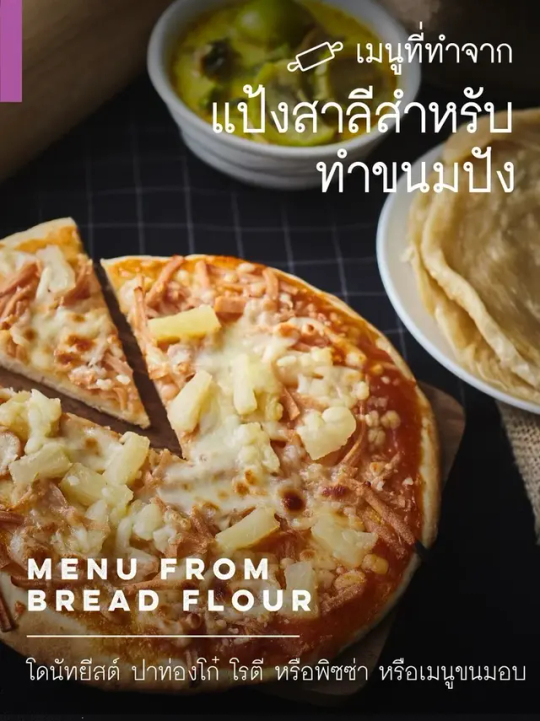
เมนูที่ทำจากแป้งสาลีทำขนมปัง
7.2. แป้งสาลีอเนกประสงค์ (All purpose Flour)
แป้งสาลีอเนกประสงค์ เนื้อแป้งจะละเอียดกว่าแป้งสาลีชนิดที่ใช้ทำขนมปังเล็กน้อย ราคาถูกกว่า ทำมาจากข้าวสาลีชนิดหนักและชนิดเบาผสมกัน มีปริมาณโปรตีน 9-10%
เมนูที่ทำจากแป้งสาลีทำอเนกประสงค์ ไม่ว่าจะเป็นอาหารและขนมต่างๆ เช่น แพนเค้ก คุ้กกี้ พาย โดนัท กะหรี่พัฟ รวมทั้งยังสามารถนำไปผสมน้ำเพื่อชุบอาหารต่างๆ ก่อนนำไปทอด
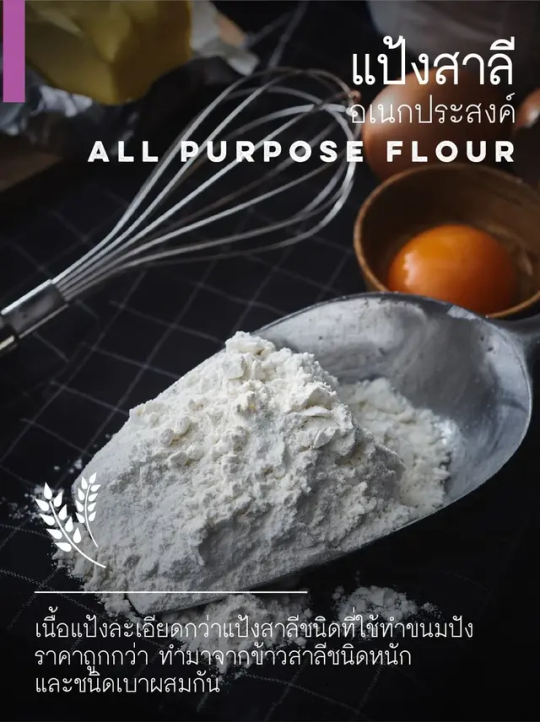
แป้งสาลีอเนกประสงค์
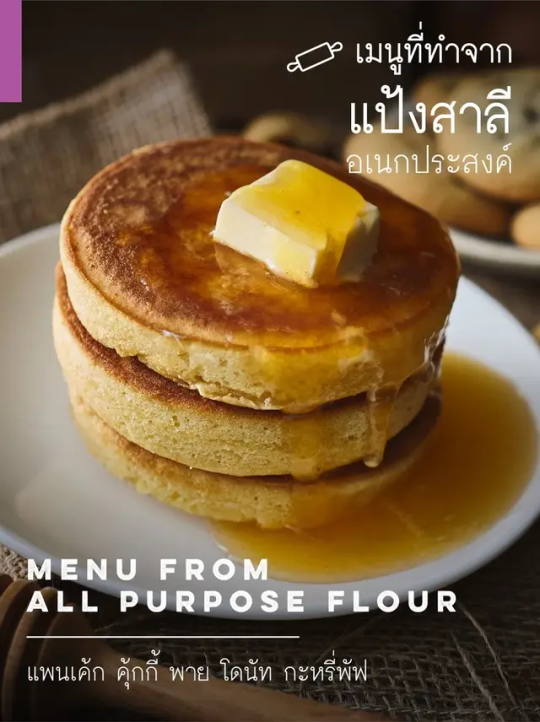
เมนูที่ทำจากแป้งสาลีทำอเนกประสงค์
7.3. แป้งสาลีสำหรับทำเค้ก (Cake Flour / Soft Flour)
แป้งสาลีสำหรับทำเค้ก บางคนอาจเรียกว่าแป้งเค้ก เนื้อแป้งมีสีขาวนวล และมีความเนียนละเอียดกว่าแป้งสาลีชนิดอื่น ๆ ดูดซับน้ำไม่ค่อยดี ไม่ค่อยเหนียวเมือเทียบกับแป้งทำขนมปัง ทำมาจากข้าวสาลีชนิดเบา มีปริมาณโปรตีน 6-9%
เมนูที่ทำจากแป้งสาลีสำหรับทำเค้ก สามารถนำไปทำขนมเค้กทุกชนิด ส่วนเมนูที่ทำจากแป้งสาลีสำหรับทำเค้ก ได้แก่ ขนมปุยฝ้าย ขนมกลีบลำดวน ขนมสาลี่

แป้งสาลีสำหรับทำเค้ก
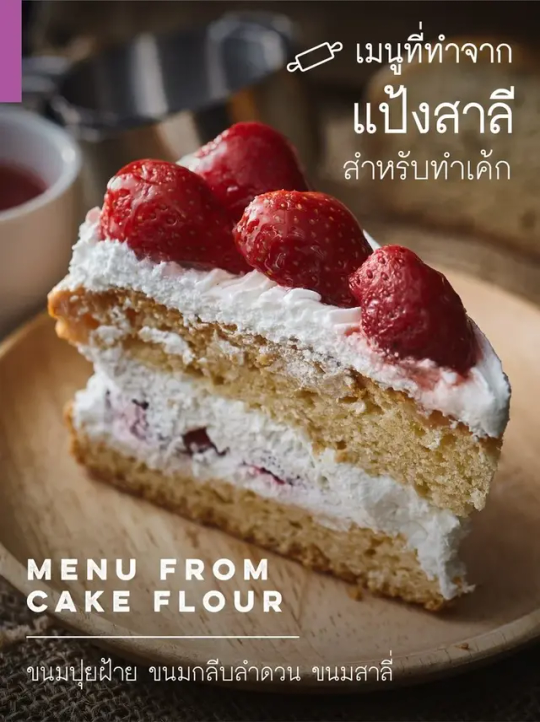
เมนูที่ทำจากแป้งสาลีสำหรับทำเค้ก
8. แป้งมันฮ่องกง (Potato starch)
แป้งมันฮ่องกง ชื่อนี้อาจจะไม่ค่อยคุ้นหู เป็นแป้งที่ทำจากมันฝรั่ง ตัวแป้งเมื่อสุกแล้วจะมีความเหนียวข้น สีใสกว่าแป้งมันสำปะหลังหรือแป้งข้าวโพด ข้อดีของแป้งมันฮ่องกงจะมีความเหนียวไม่คืนตัว แม้จะเย็นตัวลงแล้วก็จะคงความเหนียว
เมนูที่ทำจากแป้งมันฮ่องกง ส่วนใหญ่มักจะเป็นเมนูอาหาร อย่าง ราดหน้า เป็นแป้งที่คนจีนนิยมใช้ในการทำอาหาร
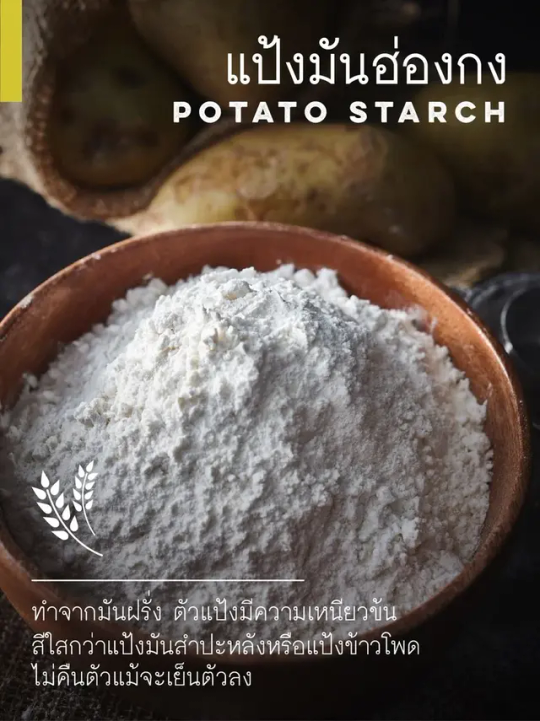
แป้งมันฮ่องกง
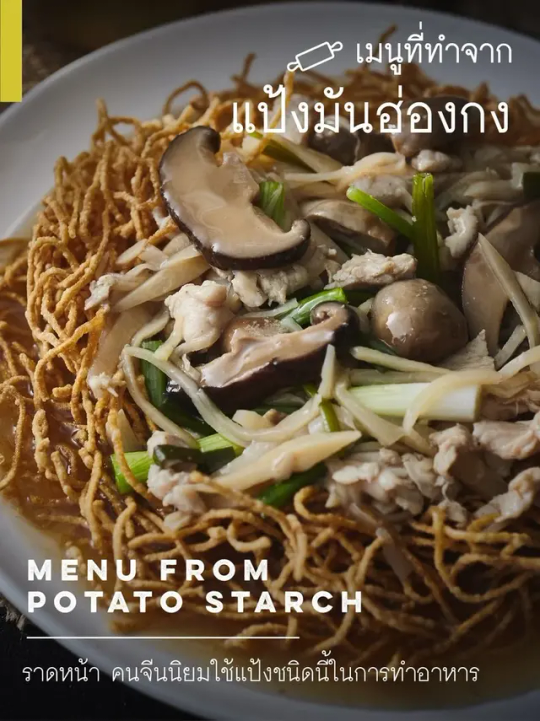
เมนูที่ทำจากแป้งมันฮ่องกง
แป้งข้าวเจ้า , Rice flour , แป้งข้าวเหนียว , Glutinous flour , แป้งมันสำปะหลัง , Tapioca starch , Cassava starch , แป้งข้าวโพด บดละเอียด , Corn starch , แป้งข้าวโพด บดหยาบ , Corn Meal , แป้งเท้ายายม่อม , Arrowroot Starch , แป้งถั่วเขียว , Mung bean Starch , แป้งสาลีสำหรับทำขนมปัง , Bread Flour , Hard Flour , แป้งสาลีอเนกประสงค์ , All purpose Flour , แป้งสาลีสำหรับทำเค้ก , Cake Flour , Soft Flour , แป้งมันฮ่องกง , Potato starch , Types Of Flour

Cr. http://www.thaikasetsart.com/ , https://www.wongnai.com/food-tips/types-of-flour ,
#แป้งข้าวเจ้า#Rice flour#แป้งข้าวเหนียว#Glutinous flour#แป้งมันสำปะหลัง#Tapioca starch#Cassava starch#แป้งข้าวโพด บดละเอียด#Corn starch#แป้งข้าวโพด บดหยาบ#Corn Meal#แป้งเท้ายายม่อม#Arrowroot Starch#แป้งถั่วเขียว#Mung bean Starch#แป้งสาลีสำหรับทำขนมปัง#Bread Flour#Hard Flour#แป้งสาลีอเนกประสงค์#All purpose Flour#แป้งสาลีสำหรับทำเค้ก#Cake Flour#Soft Flour#แป้งมันฮ่องกง#Potato starch#แป้งทำอาหาร มีกี่ชนิด#Types Of Flour
2 notes
·
View notes
Text

🌺🥑🎉 Celebrate National Tapioca Day on RAW1111.COM! 🧋🎉 Enjoy delicious vegan recipes and fun facts. #GVWU Go Vegan With Us and join the tapioca fun! 🌱✨
#tapioca#cassava#tapioca pearls#tapioca starch#crueltyfree#rooted#vegan#raw vegan#vegan food#nature#fruits#vegetables#gvwu#realnessalwayswins#plantbased#vegan lifestyle#boba tea#educate yourself#education#south america#africa#carribbean#asian
5 notes
·
View notes
Text
Tapioca Starch vs Cornstarch: Which is Better for Baking?

When it comes to baking, choosing the right starch can make a noticeable difference in texture, taste, and overall results. Two of the most common starches used in kitchens around the world are tapioca starch and cornstarch. But when you're standing in your kitchen, recipe in hand, which one should you reach for?
At Sudev International, we provide high-quality tapioca starch for baking and food applications. In this blog, we'll help you understand the difference between tapioca starch and cornstarch, so you can choose the right one for your recipe.
What is Tapioca Starch?
Tapioca starch is extracted from the root of the cassava plant. It is naturally gluten-free and has a fine, smooth texture. This starch is popular in gluten-free baking because it adds moisture, chewiness, and flexibility to baked goods.
Common uses in baking include:
Thickening fruit fillings in pies
Creating soft, springy textures in breads and cakes
Adding crispness to the crust of cookies or pastries
What is Cornstarch?
Cornstarch is made from the starchy part of corn kernels. It is widely used as a thickening agent in both cooking and baking. In baking, it helps soften the texture of cakes, cookies, and other delicate desserts.
Common uses in baking include:
Lightening cake flour for softer cakes
Making smooth puddings and custards
Creating a crispy coating in baked or fried items
Key Differences Between Tapioca Starch and Cornstarch
Let’s explore the major differences that make each starch unique in the baking world.
1. Source
Tapioca starch comes from the cassava root. Cornstarch is derived from corn.
2. Texture
Tapioca starch gives a silky and chewy finish to baked goods. Cornstarch creates a firmer, more structured texture.
3. Thickening Ability
Tapioca starch thickens at lower temperatures and holds its structure well, even after freezing. Cornstarch thickens quickly but may separate when frozen and thawed.
4. Appearance
Tapioca starch gives a clear, glossy look, perfect for fruit fillings or glazes. Cornstarch often results in a cloudy or dull appearance, ideal for puddings and sauces.
5. Taste
Both are neutral in taste, though some people feel cornstarch has a slight aftertaste. Tapioca starch has a completely clean, neutral flavor that blends well into all recipes.
Benefits of Tapioca Starch in Baking

Tapioca starch is a go-to ingredient in gluten-free and allergy-friendly baking. It works well in combination with other gluten-free flours and adds structure without making baked items dry.
Why bakers choose tapioca starch:
Adds a chewy, elastic quality to cookies and breads
Helps dough stretch and hold shape
Keeps baked goods moist for longer
Gives a smooth texture to fillings and sauces
Benefits of Cornstarch in Baking

Cornstarch is traditionally used to modify the texture of baked goods. It is especially useful in softening flour blends and making tender cakes and crumbly cookies.
Why cornstarch is useful in baking:
Softens flour and improves cake tenderness
Thickens custards and sauces quickly
Helps create a light, flaky texture in cookies and crusts
Can You Substitute Tapioca Starch for Cornstarch?
Yes, you can use tapioca starch instead of cornstarch in many recipes. However, the measurement is slightly different. Since tapioca starch has a slightly lower thickening power, you’ll need to use a bit more.
Substitution rule: Use 2 tablespoons of tapioca starch for every 1 tablespoon of cornstarch.
Tips for using tapioca starch:
Don’t overcook it, or it may lose its thickening ability
Always mix it with cold water before adding it to hot ingredients
It works best in quick-thickening recipes and fruit-based fillings
Which One Should You Use?
It all depends on what you're baking and the texture you're looking for.
Choose tapioca starch if:
You’re baking gluten-free recipes
You want a clear, glossy finish in pies or sauces
You plan to freeze your baked goods
Choose cornstarch if:
You want a softer texture in cakes or cookies
You’re making puddings, custards, or other creamy desserts
Freezing isn’t necessary for your recipe
Final Thoughts
Both tapioca starch and cornstarch have their place in the kitchen. Understanding the differences can help you get the best results from your baking. If you’re looking for a starch that’s perfect for gluten-free recipes and gives a glossy, smooth texture, tapioca starch is an excellent choice.
At Sudev International, we supply premium-quality tapioca starch that meets the needs of home bakers, food manufacturers, and chefs across the globe. Our starch is clean, consistent, and perfect for a wide range of applications in baking and cooking.
Know more https://www.sudevinternational.com/post/tapioca-starch-vs-cornstarch-for-baking
0 notes
Text
#frosting#ermine frosting#gluten free ermine frosting#gluten free#sugarologie#tapioca starch#tapioca flour#corn starch#cornstarch#sweet rice flour
0 notes
Photo

Pan de Queso Brazilian Cheese Buns Recipe The tapioca starch used in this quick and simple gluten-free recipe gives these soft and cheesy Pan de Queso their distinct puff.
0 notes
Text
Gluten Free Nutmeg Biscuits Recipe
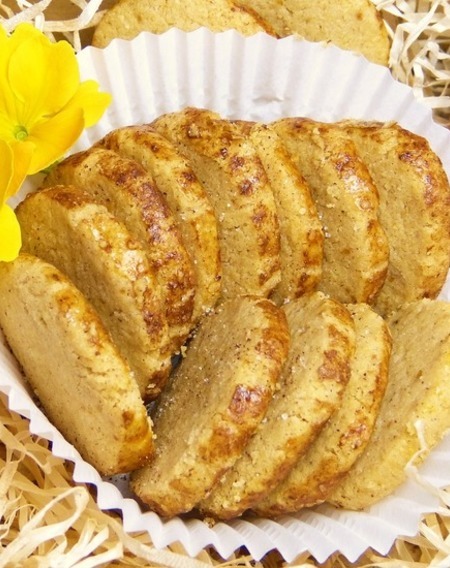
These gluten-free nutmeg biscuits are a delectable treat for everyone. They are healthy and filling because they are made with almond flour, coconut flour, and coconut sugar.
0 notes
Text
Har Gow Chinese Shrimp Dumplings

Har Gow Chinese Shrimp Dumplings. Soy Sauce, Shrimp, White Pepper, Ginger, Cornflour, Vegetable Oil, Sesame Oil, Salt, Scallions, Vegetable Oil, Salt, Tapioca Starch, Rice Vinegar, Starch. Har Gow, also known as prawn dumplings, is a traditional Chinese dim sum dish. The delicate wrapper is made of wheat starch and tapioca starch, which gives it a slight translucent appearance. The filling is a savoury combination of shrimp, scallions, and spices that makes it the ideal bite-sized snack or appetiser.
0 notes
Text

Pistachio Cake (Small Batch)
#pistachio#cake#food#dessert#loaf#baking#recipe#nuts#green#color#pink#pomegranate#fruit#glaze#small batch#tapioca starch#tapioca#strawberry#berries#summer#tea time
261 notes
·
View notes
Text


Bánh Mì Sauce (Vegan)
#vegan#condiments#vietnamese cuisine#southeast asian cuisine#sauces#diy#bánh mì sauce#tomatoes#garlic#shallots#green onion#sweet chili sauce#vegan oyster sauce#soy sauce#chinese 5 spice#tapioca starch#cilantro#cane sugar#black pepper
56 notes
·
View notes
Text
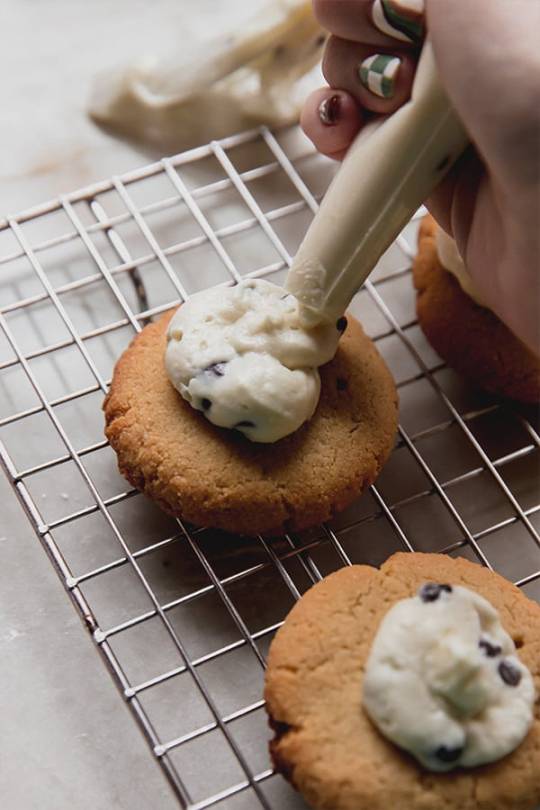

Cannoli Thumbprint Cookies (via Unbound Wellness)
#dairy free#gluten free#gf food#gluten free foods#dessert#cookies#almond flour#tapioca starch#vegan#egg free#grain free#coconut oil#maple syrup#chocolate chips#unboundwellness
20 notes
·
View notes
Text
Gluten Free Nutmeg Biscuits
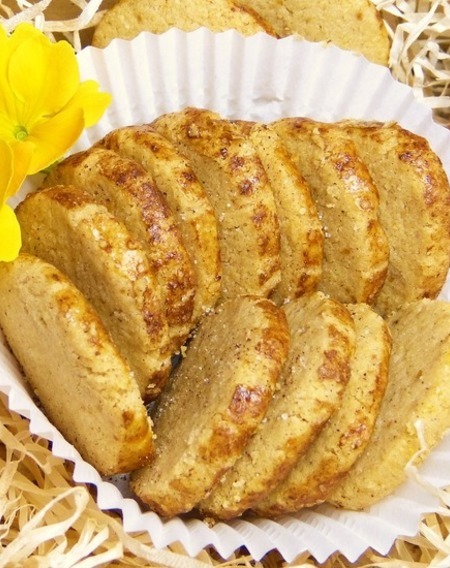
Gluten Free Nutmeg Biscuits. Baking Soda, Coconut Oil, Coconut Sugar, Nutmeg, Almond Flour, Tapioca Starch, Egg, Coconut Flour, Salt. These gluten-free nutmeg biscuits are a delectable treat for everyone. They are healthy and filling because they are made with almond flour, coconut flour, and coconut sugar.
0 notes
Photo
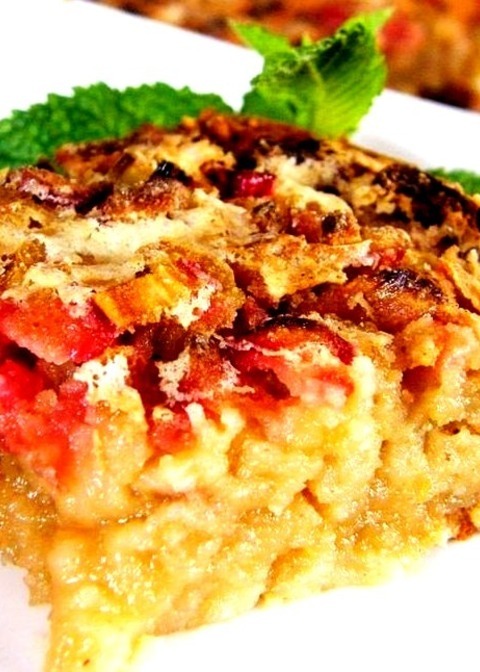
Gluten-Free Rhubarb Bars These delicious gluten-free rhubarb bars are made with rice flour; top with whipped cream or ice cream.
0 notes
Text
Har Gow Chinese Shrimp Dumplings Recipe

Soy Sauce, Shrimp, White Pepper, Ginger, Cornflour, Vegetable Oil, Sesame Oil, Salt, Scallions, Vegetable Oil, Salt, Tapioca Starch, Rice Vinegar, Starch. Har Gow, also known as prawn dumplings, is a traditional Chinese dim sum dish. The delicate wrapper is made of wheat starch and tapioca starch, which gives it a slight translucent appearance. The filling is a savoury combination of shrimp, scallions, and spices that makes it the ideal bite-sized snack or appetiser.
0 notes